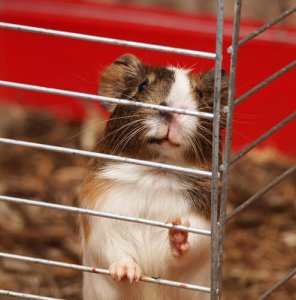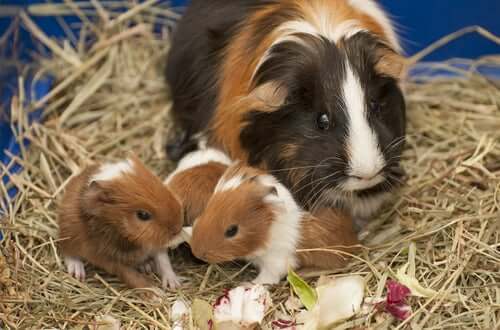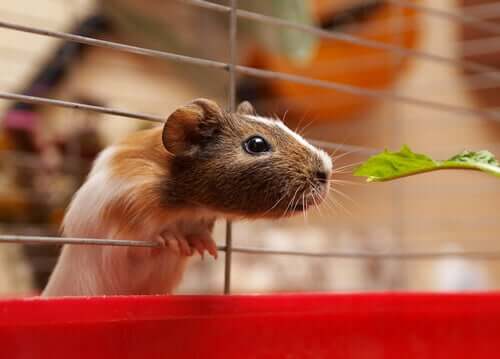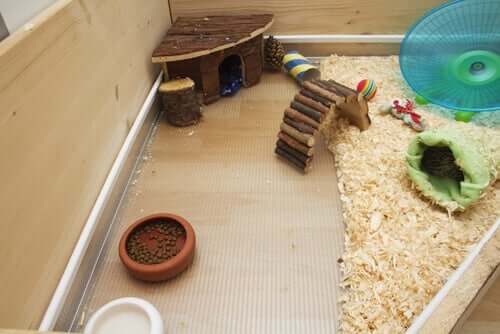How to Prepare Your Guinea Pig's Cage

For years, guinea pigs have been one of the most popular domestic pets. However, it seems like they’re particularly on-trend right now. There are many homes that have these endearing rodents as family pets. So, would you like to know how to prepare your guinea pig’s cage and the elements you need to include? We’ll tell you all you need to know!
How to prepare your guinea pig’s cage
In order to be successful in creating the perfect home for your new pet, there are a number of factors you need to keep in mind. You can read more about them below…
The size of your guinea pig’s cage
The size of your guinea pig’s cage plays a fundamental role in making your pet feel at home. Choose a cage that’s as large as possible– as a minimum, it should measure 47 x 23 x 17 inches. This will give the animal enough space to move around and offer a variety of spaces that it can utilize.
The height of your guinea pig’s cage is another factor you need to consider. The taller the cage, the more slides and levels that you can add. Remember that guinea pigs need to stay active in order to not get bored.
The floor of the cage
You’ll need to add some sort of bedding to cover the floor of your pet’s cage to absorb your guinea pig’s urine and feces. This will help to prevent unpleasant odors and, at the same time, keep your pet from being in direct contact with its own waste. You should make sure to lay down a layer of bedding that’s at least an inch thick.

You’ll need to renew the bedding in your guinea pig’s cage on a weekly basis. Or, you can do so every five days in order to maintain hygiene and cleanliness in your animal’s environment.
Clean and fresh water
Constant access to clean and fresh water is essential for your pet guinea pig. It may seem ridiculous to remind you of this, but it’s very easy to forget and then suddenly notice that your pet is out of water. Check your guinea pig’s water several times a day to make sure that doesn’t happen.
If you’ve chosen a water bottle that attaches to the bars of your guinea pig’s cage, make sure that the animal understands its purpose. There’s a good chance your pet won’t recognize the strange apparatus and, therefore, not drink water. If you notice your guinea pig isn’t catching on, then simply place a small bowl of water within the cage.
Food for your guinea pig
This is another issue that seems obvious but which is important to point out. You need to purchase food that’s specifically made for this type of animal. The food should have a large vitamin C content, as this is very important for guinea pigs.

Don’t forget to include some fruit and vegetables in your guinea pig’s diet as well. For example, apple, lettuce, celery, carbon, pear, and watermelon tend to be the favorites. What’s more, don’t forget to place hay in your pet’s cage to strengthen its teeth.
Make a nest
In order to place hay in the cage–which is so essential for your pet’s dental health— you should build a nest. This will help your guinea pig feel like it’s in its natural environment. There, your pet will be able to find shelter, sleep whenever it wants, and feel right at home.
This can also be an enclosed cage, like a small house, for example. Just remember, you have to give your pet hay and bedding to make it comfortable.
Toys to entertain your guinea pig
Guinea pigs have a tendency to get bored very easily, so they need things to do in order to stay active. Add additional levels, tunnels, boxes to climb on, trunks to roll, etc, to your guinea pig’s cage. Anything that you can find in the pet shop that will add a bit of fun to your pet’s life!

Guinea pigs are curious by nature. They love to play and discover new things. Preparing your guinea pig’s cage so that it meets all of the animal’s needs is no simple task. However, if you follow our advice, you’ll no doubt create the ideal home for your beloved pet.
No matter what kind of pet you own, having a pet comes with the responsibility and obligations when caring for your pet’s well-being. Don’t forget it.
For years, guinea pigs have been one of the most popular domestic pets. However, it seems like they’re particularly on-trend right now. There are many homes that have these endearing rodents as family pets. So, would you like to know how to prepare your guinea pig’s cage and the elements you need to include? We’ll tell you all you need to know!
How to prepare your guinea pig’s cage
In order to be successful in creating the perfect home for your new pet, there are a number of factors you need to keep in mind. You can read more about them below…
The size of your guinea pig’s cage
The size of your guinea pig’s cage plays a fundamental role in making your pet feel at home. Choose a cage that’s as large as possible– as a minimum, it should measure 47 x 23 x 17 inches. This will give the animal enough space to move around and offer a variety of spaces that it can utilize.
The height of your guinea pig’s cage is another factor you need to consider. The taller the cage, the more slides and levels that you can add. Remember that guinea pigs need to stay active in order to not get bored.
The floor of the cage
You’ll need to add some sort of bedding to cover the floor of your pet’s cage to absorb your guinea pig’s urine and feces. This will help to prevent unpleasant odors and, at the same time, keep your pet from being in direct contact with its own waste. You should make sure to lay down a layer of bedding that’s at least an inch thick.

You’ll need to renew the bedding in your guinea pig’s cage on a weekly basis. Or, you can do so every five days in order to maintain hygiene and cleanliness in your animal’s environment.
Clean and fresh water
Constant access to clean and fresh water is essential for your pet guinea pig. It may seem ridiculous to remind you of this, but it’s very easy to forget and then suddenly notice that your pet is out of water. Check your guinea pig’s water several times a day to make sure that doesn’t happen.
If you’ve chosen a water bottle that attaches to the bars of your guinea pig’s cage, make sure that the animal understands its purpose. There’s a good chance your pet won’t recognize the strange apparatus and, therefore, not drink water. If you notice your guinea pig isn’t catching on, then simply place a small bowl of water within the cage.
Food for your guinea pig
This is another issue that seems obvious but which is important to point out. You need to purchase food that’s specifically made for this type of animal. The food should have a large vitamin C content, as this is very important for guinea pigs.

Don’t forget to include some fruit and vegetables in your guinea pig’s diet as well. For example, apple, lettuce, celery, carbon, pear, and watermelon tend to be the favorites. What’s more, don’t forget to place hay in your pet’s cage to strengthen its teeth.
Make a nest
In order to place hay in the cage–which is so essential for your pet’s dental health— you should build a nest. This will help your guinea pig feel like it’s in its natural environment. There, your pet will be able to find shelter, sleep whenever it wants, and feel right at home.
This can also be an enclosed cage, like a small house, for example. Just remember, you have to give your pet hay and bedding to make it comfortable.
Toys to entertain your guinea pig
Guinea pigs have a tendency to get bored very easily, so they need things to do in order to stay active. Add additional levels, tunnels, boxes to climb on, trunks to roll, etc, to your guinea pig’s cage. Anything that you can find in the pet shop that will add a bit of fun to your pet’s life!

Guinea pigs are curious by nature. They love to play and discover new things. Preparing your guinea pig’s cage so that it meets all of the animal’s needs is no simple task. However, if you follow our advice, you’ll no doubt create the ideal home for your beloved pet.
No matter what kind of pet you own, having a pet comes with the responsibility and obligations when caring for your pet’s well-being. Don’t forget it.
This text is provided for informational purposes only and does not replace consultation with a professional. If in doubt, consult your specialist.








